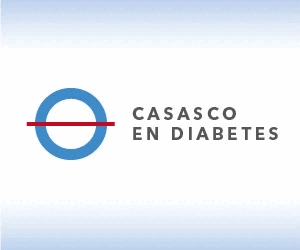Consenso pie diabético ALAD - GLEPED
DOI:
https://doi.org/10.47196/diab.v47i3.214Palabras clave:
pie diabético, complicacionesResumen
En Latinoamérica los estudios sobre prevalencia, incidencia, discapacidad, días laborales perdidos y costos por hospitalización a causa del pie diabético y sus complicaciones son escasos y diversos. En los estudios nacionales reportados por Argentina, Barbados, Brasil y Cuba, el rango de amputaciones del pie secundario a la Diabetes Mellitus (DM) oscila entre el 45 y el 75% de todas las causas de las amputaciones.
Las úlceras y amputaciones constituyen un gran problema de salud que genera un alto costo para el paciente, sus familiares y los sistemas de salud pública que se ven obligados a destinar en subsidios y atención médica recursos importantes que pudieran emplearse para programas sociales, de investigación o desarrollo tecnológico.
Citas
International Diabetes Federation. Diabetes Atlas (3rd edition). Brussels, 2006.
Sereday Bragnolo JC, Martí ML, Tesone C, Tesone PA. Pacientes amputados de miembros inferiores. Estudios en 4 hospitales de la Ciudad de Buenos Aires. 1995-1997. Revista Sociedad Argentina de Diabetes; 34:87-88 20002.
Spichler ERS, Spichler D, Lessa I, Forti AC, Franco LJ, Franco LJ, La Porte RE (2001). Capture-Recapture methods to estimate lower extremity amputation rates in Rio de Janeiro, Brazil. Rev Panam Salud Publica 10:334-340.
Walrond ER. The Caribbean experience with the management of the diabetic foot. West Indian Med J 2001; 50: (S1): 24-26.
Chatuverdi N; Stevens LK; Fuller JH; Lee ET; Lu M and the WHO Multinational Study Group. Risk factors, ethnic differences and mortality associated with lower-extremity gangrene and amputation in diabetes. The WHO multinational study group of vascular disease in diabetes. Diabetologia (2001) 44 (Suppl 2); S65-S71.
Resende KF. Predisposing factors for amputation of lower extremities in diabetic patients with foot ulceration in the state of Sergipe. J Vasc Bras 2006; 5 (2): 123-30.
Unwin N. The diabetic foot in the developing world. Diabetes Metab Res Rev 2008; 24: (Suppl 1)S31-S33.
Boulton AJM, Vileikyte L, Ragnarson-Tennvall G, Apelqvist J. The global burden of diabetic foot disease. Lancet 2005; 366:1719-1724.
Reiber GE, Vileikyte L, Boyko EJ, et al. Causal pathways for incident lower extremity ulcers in patients with diabetes from two settings. Diabetes Care1999; 22: 157-162.
Pecoraro RE, Reiber GE, Burgess EM. Pathways to diabetic limb amputation: basis for prevention. Diabetes Care 1990; 13: 510-521.
Singh N, Armstrong DG, Lipsky BA. Preventing foot ulcers in patients with Diabetes. JAMA 2005; 293: 217-228.
International Consensus Group on the Diabetic Foot and Practical Guidelines on the Management and the Prevention of the Diabetic Foot, Versions 1999, 2003, 2007. Amsterdam, The Netherlands, available on CD-ROM (www.idf.org∕bookshop).
Boulton AJM, Armstrong D, Albert S, Fryberg R, Hellman R, Kirkman M, Lavery L, Lemaster J, Mills J, Mueller M, Sheehan P, Wukich D. ADA-AACE Task Force. Diabetes Care 31:1679-1685, 2008.
American Diabetes Association. Recommendations. Suppl 1, 2009.
Booth J, Young MJ. Differences in the performance of commercially available 10g-monofilaments. Diabetes Care 2000; 23:984-988.
Abbot CA, Carrington AL, Ashe H et al. (2002). The north-west diabetes foot care study: incidence of, and risk factors for, new diabetic foot ulceration in a community-based patient cohort. Diabet Med 20:377-384.
La polineuropatía diabética periférica. Guia NeurALAD, 2009 (in press) Publicada.
Peters EJ, Lavery LA. Effectiveness of the diabetic foot risk classification of the International Working Group on the Diabetic Foot. Diabetes Care 2001; 24: 1442-1447.
Lavery L,Peters E: Reevaluating the way we classify the diabetic foot: Diabetes Care 31:154-156, 2008.
Schaper NC. Diabetic foot classification system for research purposes: a progress report on criteria for incluiding patients in research studies. Diabetes Metab Res Rev 2004; 20 (Suppl 1): S90-S95.
Jeffcoate WJ, Game FL. The description and classification of diabetic foot lesions: systems for clinical care, for research and for audit. In: Boulton AJM, Cavanagh P, Rayman G, eds. The Foot in Diabetes 4 th edition, Chichester, J Wiley & Sons: 2006: pp 92-107.
Armstrong DG, Lavery LA, Harkless LB. Validation of a diabetic wound classification system: contribution of depth, infection, and vascular disease to the risk of amputation. Diabetes Care 1998 21; 855-859.
Armstrong DG, Lavery LA. Foot Pocket Examination Chart from Clinical care of the Diabetic Foot. 2005. Alexandria, Virginia: American Diabetes Association, 2008.
Jeffcoate WJ, Price P, Harding KG. Wound healing and treatment for the people with diabetic foot ulcers. Diabetes Metab Res Rev 2004; 20 (Suppl 1): 78-79.
Bowling FL, Boulton AJM. Management of the diabetic foot. In: Tesfaye S, Boulton AJM, eds. Diabetic Neuropathy. Oxford Diabetes Library, Oxford University Press: 2009: 9 pp 81-93.
Frykberg R, Zgonis T, Armstrong D, Driver V, Giurini J, Kravitz S, Landsman A, Lavery L, Moore C, Vanore J. Diabetic Foot Disorders: A Clinical Practice Guideline. The Journal of Foot and Ankle Surgery. 45; September/October 2006.
Cavanagh P, Tammy O. Nonsurgical strategies for healing and preventing recurrence of Diabetic Foot Ulcers. Foot and Ankle Clinics 11; (2006): 735-743.
Dennis J, Erik J. Management of the diabetic foot. Foot and Ankle Clinic 11; (2006): 717-734.
Van Schie C. Ulbrecht JS., Baker MB, et al. Design criteria for rigid rocker shoes. Foot and Ankle Int. 2000; 21; (10):833-44.
Eichenholtz S. Charcot Joints. Springfield (IL); Charles C. Thomas; 1966.
Jeffcoate WJ, Game FL, Cavanagh PR. The role of proinflammatory cytokines in the cause of neuropathic osteoarthropathy (acute Charcot foot) in diabetes. Lancet 2005; 366: 2058-2081.
Jeffcoate WJ. Charcot neuro-arthropathy. Diabetes Metab Res Rev 2008; 24 (Suppl 1): S62-S65.
Benjamin Lipsky. Infectious problems on the foot in diabetic patients. John H. Bowker, Michael Pfeifer, eds. Levin and O´Neal´s The Diabetic Foot 6th edition, Mosby: 2001 pp 467-480.
M. Lindsay Grayson, Gary W. Gibbons. Karoly Balogh, Elaine Levinm, Adolf W. Karchmer. Probing to bone in infected pedal ulcers: A clinical sign of underlying osteomyelitis in diabetic patients. JAMA.1995; 273 (9):721-723.
Mark H. Ekman, Sheldon Greenfield, William C. Mackey, John B. Wong, Sherrie Kaplan, Lisa Sullivan, Kim Dukes, Stephen G. Pauker. Foot Infections in Diabetic Patients. JAMA. 1995;273:712-720.
A Delcourt, D Huglo, T Prangeres, H. Bentiche, F Devemy, D Tsirtsikoulou, M Lepeut, P. Fontaine, M Steinling. Comparison between Leukoscan® (Sulesomab) and Gallium-67 for the diagnosis of osteomyelitis in the diabetic foot. Diabetes Metab. 2005 Apr; 31(2):125-133.
Vardakas ZK, Horianopolou M, Falagas ME. Factors associated with treament failure in patients with diabetic foot infections: An analysis of data from randomized controlled trials. Diabetes Res Clin Prac 80 (2008): 344-351.
Jeff G. van Baal, Keith G.Harding and Benjamin Lipsky. Foot infections in Diabetic Patients: An overview of the problem. Clinical Infectious Diseases 2004;39:S71-2.
Masson EA, Hay EM, Stockley I, Betts RP, Boulton AJM (1989). Abnormal foot pressures alone may not cause ulceration. Diabet Med 6:426-429.
Veves A, Murray HJ, Young MJ, Boulton AJM. The risk of foot ulceration in diabetic patients with high foot pressure: a prospective study. Diabetologia. 1992; 35:660-663.
van Schie CHM. Neuropathy: mobility and quality of life. Diabetes Metab Res Rev 2008; 24 (Suppl 1): S45-S51.
van Schie CH, Abbot CA, Vileikyte L, et al. A comparative study of Podotrack and the optical pedobarograph in the assessment of pressures under the diabetic foot. Diabet Med 1999; 16: 154-159.
Cavanagh PR, Ulbrecht JS. What the Practicing clinician should know about foot biomechanics. In: Boulton AJM, Cavanagh P, Rayman G, eds. The Foot in Diabetes 4 th edition, Chichester, J Wiley & Sons: 2006: pp 68-91.
Wild S, Green A, Sicree R, King H. Global prevalence of diabetes: estimates for the year 2000. and projections for 2030. Diabetes Care 2004; 27 (5):1047-1053.
Venkat NKM, Zhang P, Kanaya AM et al. Diabetes: the pandemic and potential solutions. In: Disease Control Priorities in Developing Countries (2nd ed), Jaminson, Breman Measham (eds). World Bank-Oxford University Press, NY, 2006; 591-604.
Litzelman DK, Slemenda CW, Langerfield CD, et al. Reduction of lower extremity clinical abnormalities in patients with non-insulin-dependent diabetes mellitus. A randomized, controlled trial. Ann Intern Med. 1993; 119: 36-41.
Mccabe CJ, Stevenson RC, Dolan AM. Evaluation of a diabetic foot screening and protection programme. Diabet Med 1998; 15: 80-84.
National Institute of Clinical Excellence (NICE). Clinical Guidelines 10. Type 2 Diabetes: Prevention and Management of Foot Problems. London: NICE; Jan 2004. Available at: www.nice.org.uk.
Canadian Diabetes Association Clinical Practice Guidelines Expert Committee. S140. Neuropathy. Brill V, Perkins B; S143 Foot Care. Bowering K, Ekoé JM, Kalla TP, 2008.
Diabetes Association. Clinical Practice Recommendations 2009; (Suppl 1): pp S10, S35, S36.
Diretrizes da Sociedade Brasileira de Diabetes (SBD), 2009. Pé Diabético. Disponível em: www.diabetes.org.br.
Pedrosa HC, Leme LAP, Novaes C, et al. The diabetic foot in South America: progress with the Brazilian Save the Diabetic Foot Project. Int Diabetes Monitor 2004; 16 (4): 17-24
Time to Act. Van Acker K and Pedrosa HC, 2005. IDF .
Martin CL, Albers J, Herman WH, Cleary P, Waberski B, Greene DA, Stevens JM, Feldman EV. Neuropathy among the Diabetes Control and Complications Trial cohort 8 years after trial completion. Diabetes Care 2006; 29 (2):340-344.
Hollman RR et al. 10-year follow-up of intensive glucose control in type 2 diabetes. N Engl J Med 359:1577-1589, 2008.
Br. J Surg; 95 : 685-92. Nivel 1ª; Grado A).
Schintler, M. V. (2012), Negative pressure therapy: theory and practice. Diabetes Metab. Res. Rev., 28: 72–77. doi: 10.1002/dmrr.22431-Schintler, M. V. (2012),
Negative pressure therapy: theory and practice. Diabetes Metab. Res. Rev., 28: 72–77. doi: 10.1002/dmrr.2243 CT2005/01.
European Wound Management Association (EWMA). Documento de posicionamiento: La presión negativa tópica en el tratamiento de heridas.Londres: MEP Ltd, 2007.
Banwell P. Topical negative pressure therapy in wound care. J Wound Care 1999; 8(2): 79-84.
Documento de consenso. Londres: MEP Ltd, 2008. Mouës CM, Vos MC, Jan-Gert CM, et al. Bacterial load in relation to vacuumassisted closure woundtherapy: A prospective randomised trial. Wound Rep Reg 2004; 12: 11-7.
Attinger CE, Janis JE, Steinburg J, et al. Clinical approach to wounds:debridement and wound bed preparation including the use of dressings and wound-healing adjuvants. Plast Reconstr Surg 2006; 117(7 Suppl): 72S-109S.
Rooke TW y col. 2011 ACCF/AHA Focused update of the guideline for the management of patients with peripheral artery disease (updating the 2005 guideline) A Report of the American College of Cardiology Foundation/American Heart Association Task Force on Practice Guidelines Developed in Collaboration With the Society for Cardiovascular Angiography and Interventions, Society of Interventional Radiology, Society for Vascular Medicine, and Society for Vascular Surgery. J VascSurg 2011; 54(5):e38-52.
Fernandez Montequin,J; Berlanga, J; Sanchez P; Sancho, N, et al: Intralesional administration of Epidermal Growth factors based formulation (HEBERPROT P) in chronic foot ulcer: Treatment up to complete wound closure.Int. Wound J. 2009.
Fernández Montequin,J, Santiesteban,LL: ¿Puede el HEBERPROT P cambiar conceptos quirúrgicos? EN Pie Diabético: un tratamiento eficaz. Pág. 57-72, Elfos Scientiae, 2009.
Descargas
Publicado
Cómo citar
Número
Sección
Licencia

Esta obra está bajo una licencia internacional Creative Commons Atribución-NoComercial-SinDerivadas 4.0.
Dirección Nacional de Derecho de Autor, Exp. N° 5.333.129. Instituto Nacional de la Propiedad Industrial, Marca «Revista de la Sociedad Argentina de Diabetes - Asociación Civil» N° de concesión 2.605.405 y N° de disposición 1.404/13.
La Revista de la SAD está licenciada bajo Licencia Creative Commons Atribución – No Comercial – Sin Obra Derivada 4.0 Internacional.
Por otra parte, la Revista SAD permite que los autores mantengan los derechos de autor sin restricciones.



























